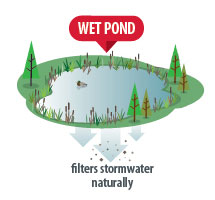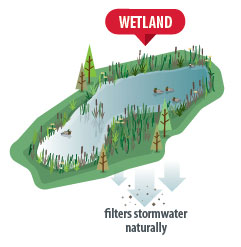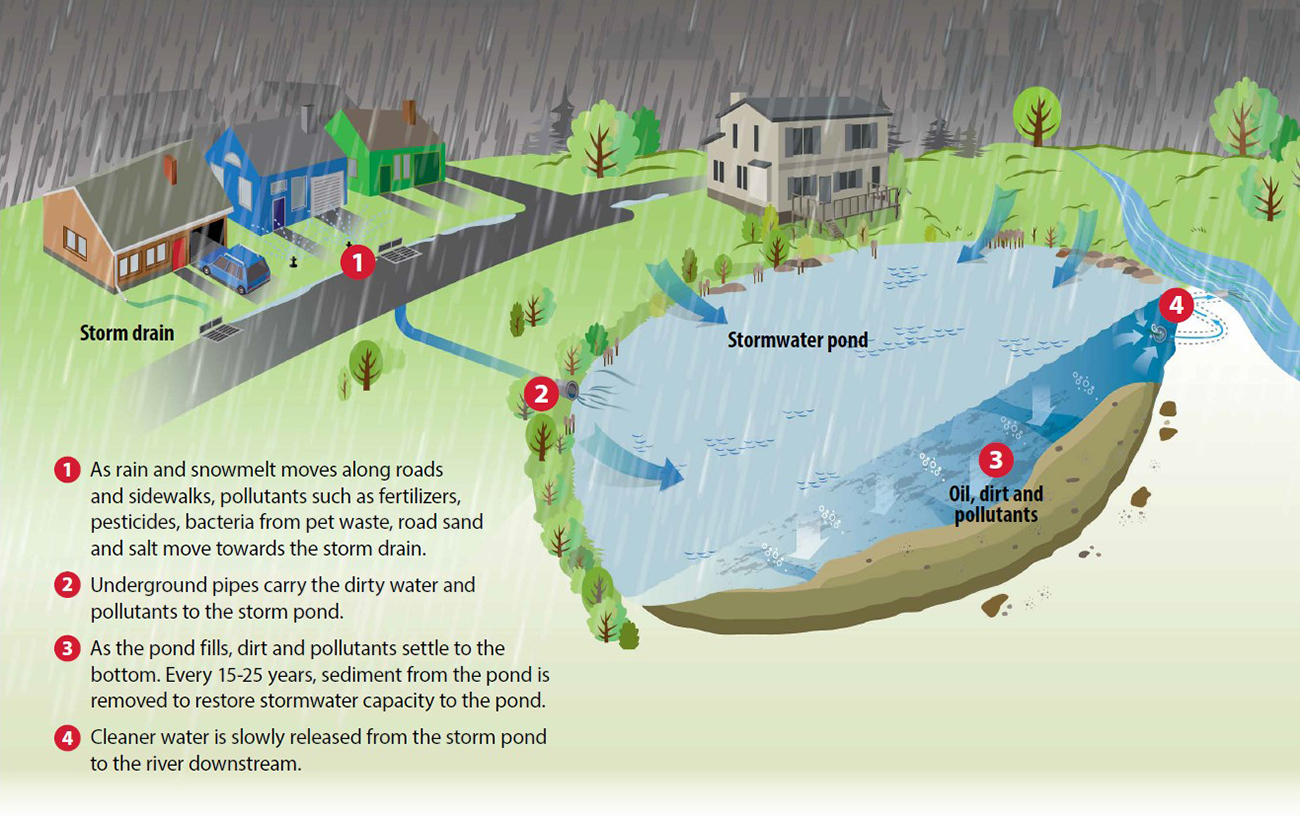Storm ponds in Calgary
The benefits of a storm pond
Some of Calgary’s newer communities have storm ponds to collect and hold rainfall and snowmelt before it reaches our rivers, creeks, and streams.
This runoff collects sediment and pollutants (e.g. bacteria, fertilizers, pesticides, vehicle fluids, metals, road salt) as it travels across properties, streets, and roads.
By capturing and holding stormwater for a period of time, storm ponds allow sediments to settle out and provide some treatment for pollutants. The water is then slowly released to our rivers, creeks, and streams.
Slowing the speed and reducing the sediments and pollutants helps keep our rivers, creeks, and streams healthier.
How does a storm pond work?
Image description: An illustration showing how rain water and snowmelt travel from storm drains to a stormwater pond.
- As rain and snowmelt moves along roads and sidewalks, pollutants such as fertilizers, pesticides, bacteria from pet waste, road sand and salt move towards the storm drain
- Underground pipes carry the dirty water and pollutants to the storm pond.
- As the pond fills, dirt and pollutants settle to the bottom. Every 15-25 years, sediment from the pond is removed to restore stormwater capacity to the pond.
- Cleaner water is slowly released from the storm pond to the river downstream.
Storm pond safety
Storm ponds have hidden hazards that can be dangerous to people and pets. Recreational activities are not allowed on them.
Learn how to stay safeTypes of storm ponds
Dry
A dry pond is dry most of the time and may have playing fields in it. During heavy rain, dry ponds will fill with water very quickly.
This prevents the stormwater system from becoming overwhelmed. This helps to prevent water from backing up into basements or flooding into houses, or businesses.
Almost all of the dry ponds have ultrasonic sensors that record water depths. The sensors also inform us when the ponds are filling with water. After a rain event, dry ponds can take up to 24 hours to drain.
Wet
Wet ponds hold water all of the time. These ponds are designed to capture and hold stormwater– for a while.
Wet ponds slow down the water, which helps settle out some of the sediments and allows some pollutants to be removed or degraded by natural environmental processes. This helps return cleaner water to our rivers, creeks, and streams.
Typically these ponds are designed to have a water depth of three metres, which can rise quickly after storms.

Constructed wetlands
A constructed wetland is an area of land that is designed to mimic a natural wetland shape and maintain appropriate water depths so that wetland type soils and native vegetation establish within it.
The plants that grow in constructed wetlands help remove and filter pollutants, like fertilizers and pesticides.
They are typically saturated with water either permanently or seasonally. While most of the water is quite shallow before a storm, they can manage high water levels during storm events.
While some natural wetlands are part of Calgary’s landscape, some are constructed (man-made) and are part of the stormwater system. To learn more, visit Conserving Our Wetlands.

Maintaining storm ponds
We design storm ponds to enhance the surroundings while requiring little maintenance. For instance, plants, trees and shrubs help maintain the integrity of the ponds while providing habitat for a variety of plants and animals species. Aquatic vegetation helps maintain water quality and reduce erosion.
Maintenance is sometimes needed to ensure storm ponds continue to provide benefits to communities without negative impact from issues such as:
Sediment
As stormwater moves through the ponds, sediment and debris settle in the ponds, allowing cleaner water to be released into our rivers. This material accumulates over time.
When necessary, we remove sediment to prevent impact to the storage capacity of the pond and environmental impacts downstream.
Algae
In most cases, algae are good for storm ponds. They consume nutrients and trap contaminants to improve water quality before it enters the river. One form of green algae, called cladophora, is prevalent in the Calgary area. It looks like stringy, fibrous mats that can be seen floating on the water’s surface. It poses no safety concerns for humans, animals, or birds, and is a natural part of a healthy storm pond.
At certain times of the year, especially during warm, dry periods, storm ponds can experience excessive algal growth (blooms) which can become unsightly and at times release unpleasant odours.
Algae blooms can be caused by several things: persistent warm weather, nutrients washed into storm ponds from lawn fertilizers, sediments washed into the pond, and dead or decaying vegetation.
The City responds to 311 calls through the summer months to monitor pond algae levels and odours, taking action when warranted.
Odour
Storm pond odour is caused by the normal decay of organic matter in the pond.
In the winter as ice forms on the surface of storm ponds it can cause the water below to become lower in oxygen which also contributes to the odour. In the spring as the ice melts, the odour-producing gas is released that was trapped under the ice. Once the ice has fully melted,
The odour is temporary and will naturally disperse once the ice on the storm pond has fully melted and mixed with the rest of the water in the pond.
While the odour is unpleasant, and potentially alarming because it may smell like natural gas, it does not pose a risk to public health or the environment at the concentrations typically found in and around storm ponds.
If you suspect a natural gas leak or the presence of other hazardous gas, we encourage you to call 9-1-1.
We take concerns about odours very seriously and thoroughly investigate them.
When an odour is reported, a Calgary fire crew attends the location to confirm that the odour is not caused by a hazardous condition such as a natural gas leak.
If the investigation indicates that the odour is entirely due to gas from the storm pond and is low in concentration, no further action is taken.
Invasive species
It’s illegal to stock or release fish into a storm pond. Prussian carp and goldfish are some of the most common invasive species found in our storm ponds.
These fish are not native to Alberta and with a lack of natural predators or pathogens to keep them in check, they multiply quickly.
If they reach the Bow River they will alter habitats, out-compete native species for limited resources and spread disease to native species.
The release of fish into a storm pond carries a fine of $3000 under Stormwater Bylaw 37M2005.
Current projects
Storm ponds and river health starts with you
Maintain your yard and property
To reduce run off and prevent pollutants from washing onto the street and entering the stormwater system.
Pick up after your pet
Place your garbage in your black cart
Limit the use of fertilizers and pesticides
Never release plants, fish or other animals into the storm ponds
(e.g. goldfish or Prussian carp) into storm ponds. Take them to the pet store or give them away. After your fish passes on don’t flush it. Bury it or dispose of it in the garbage to prevent the spread of disease.
Don’t remove, cut or prune of any vegetation
in or around the ponds or you may be fined. For more information on how to share the park boundary and encroachments on Parks land visit:
Additional resources
Download this brochure to learn more about storm ponds and how they help protect our rivers and communities:




